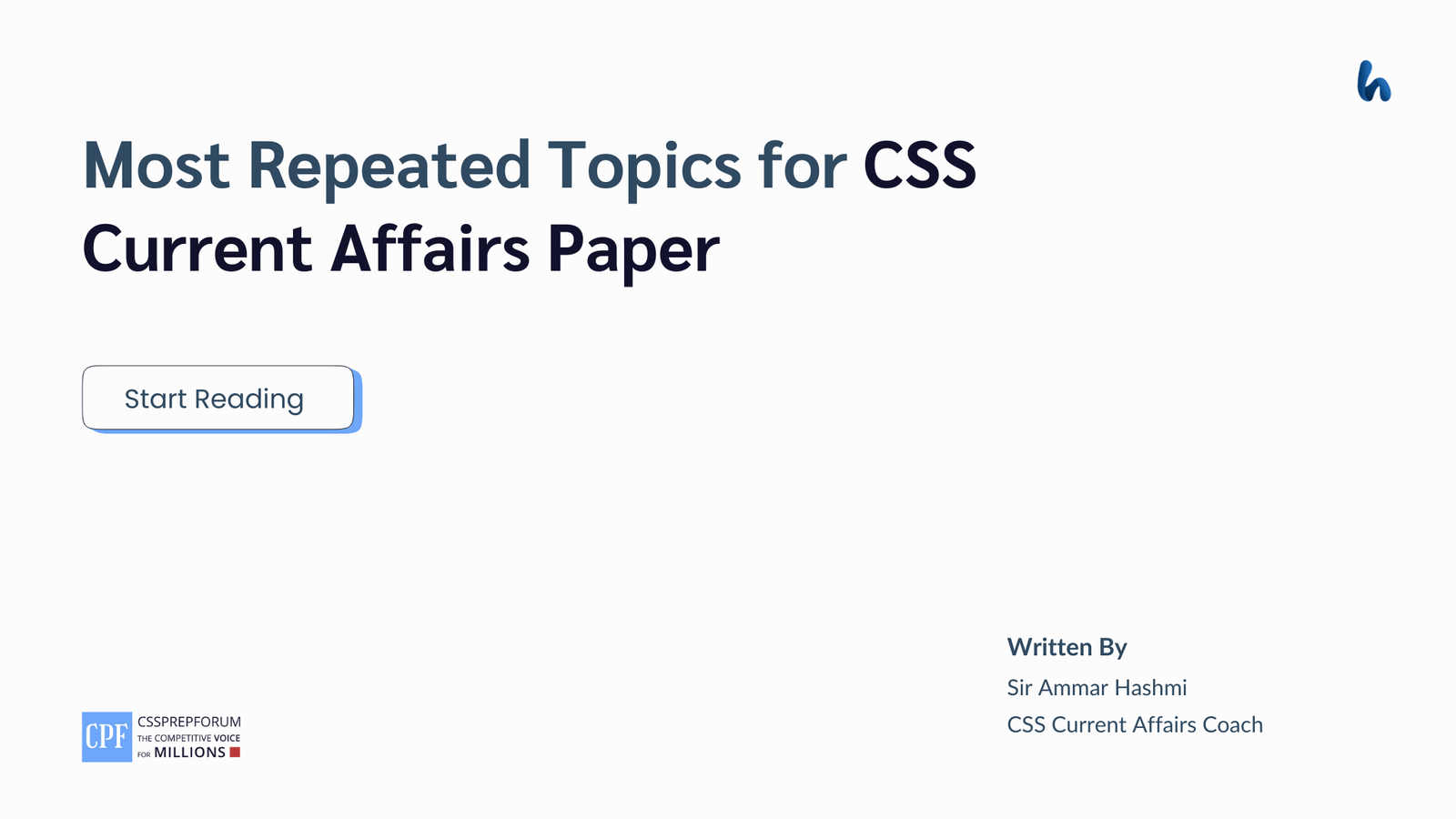The CSS Solved General Science & Ability (GSA) Past Paper 2016 is Solved by Pakistan’s top GSA Coaches, Miss Iqra Ali and Sir Ammar Hashmi. They are the only coaches available in Pakistan who have solved the last 20 years GSA solved papers to help aspirants know how to attempt the paper to score above 80. And they have guided thousands of CSS and PMS aspirants. Both coaches have been known for their teaching methodology and imparting concepts to their students, who scored the highest marks in this subject. At the special request of CSSPrepForum, both coaches have solved the paper.

Question – 02
(A) What were the main objectives of the Clean Development Mechanism? Also, explain the reasons for the criticism of the Koyoto Protocol by the developed countries.
Question Breakdown
In this question, the examiner has asked you to explain the objectives behind the “clean development mechanism” and the reasons for developing countries’ criticism of the Kyoto protocol. So, all you have to do is start with a simple definition of the subject matter (Clean development mechanism), then give a fast working, and objective of CDM. Then, link the next part of the question by defining Kyoto Protocol and giving reasons for criticism. Remember, stick to what the examiner has actually asked, and do not stretch your question with unnecessary information if not required. No diagram is needed in this question
Answer:
What is a “clean development mechanism”?
CDM is one of the three mechanisms stated in the Kyoto Protocol. The mechanism allows developed countries to play their part in reducing GHG emissions.
How does it work?
CDM is a flexible way for developed countries to counter their own high domestic GHG emissions. The developed county invests in the GHG reduction project in the developing country. Each CDM project generates CER (Certified Emission Reductions) equivalent to one ton of CO2. In this way, developed countries trade CO2 and complete their Kyoto Protocol targets.
Objectives of CDM
✔ To accomplish the overarching goal of the UNFCCC is to prevent dangerous interference with the climate system
✔ To encourage sustainable development in developing nations
✔ To reduce the cost of complying with the provisions of the Kyoto Protocol for developed nations
What is the Koyoto Protocol?
Koyoto Protocol is an international treaty made in 1992 to implement the objectives of the UNFCCC (United Nations Framework Convention on Climate Change). Kyoto Protocol binds the countries to reduce GHG (Greenhouse Gases) emissions.
Reasons for criticism of the Koyoto Protocol by developed countries
✔ Koyoto Protocol has been criticized by the United States for exempting developing countries like China and India due to their huge emissions of GHG.
✔ The level of GHG emissions at the time of the treaty and now has tremendously changed, but the targets have not changed.
✔ The GHG emission itself is dangerous, which should be reduced by the developed countries instead of trading it off with developing countries.
✔ GHG emission knows no boundaries. It is not confined to one country but spreads in the whole environment.
✔ There is a limited capacity of developing countries to offset the GHG emission of developing countries.
✔ Kyoto Protocol has not paid much attention to other pollutants such as sulfur dioxide and nitrogen oxide.
(B) Differentiate between Sanitary and Industrial Landfills, also describe the land selection criteria for Landfills
Question breakdown
In this question, the examiner has asked you to explain the difference between sanitary and industrial landfills. For answering such questions, simply, make a table and start writing differences according to several characteristics like definitions, examples, signs, etc. Remember, in a single point, only write the differences that are relevant to one characteristic; for instance, do not write the definition of sanitary landfills and examples of industrial landfills in one point.
Answer:
Difference between sanitary and industrial landfills
| Sanitary Landfills | Industrial Landfills |
| Sanitary landfills are used for the disposal of waste from homes and roads. | Industrial landfills are used for the disposal of industrial waste and effluent particularly |
| From sanitary landfills, methane is extracted | Industrial landfills also work as “material reusable facilities” in which, reusable items are extracted and sold. |
| In sanitary landfills, layers of clay are used to separate the layers of waste | In Industrial landfills, no such layers are used. |
| In sanitary landfills, pipelines are constructed to extract landfill gases. | No pipeline connections are used in industrial landfills |
Land Selection Criteria for Landfills:
1. The area and volume of the land should be sufficient enough to contain waste for several years.
2. The Landfill site should not be in close vicinity of the population.
3. They should not be close to water bodies like dams, because of the potential risk of contamination that is hazardous to aquatic life.
4. No major power transmission or other infrastructure like sewers, and water supply lines should be crossing through the landfill developmental areas.
5. Unstable areas that have a significant seismic risk which could cause the destruction of berms are not recommended for the landfill site.
6. A significantly fractured geological structure having fault lines should not be selected. The fault lines can allow unpredictable movement of gas within 500 perimeters of the proposed landfill.
7. The selection of landfill sites should be based upon the proper assessment of environmental issues.
8. The landfill site should be near the waste recycling site facility, if not, the waste recycling facility should be planned as an integral part of the landfill site.
Question – 03
(A) Write a short note on artificial intelligence.
Question Breakdown
In this question, the examiner has asked you to briefly describe artificial intelligence in your own words. So, you can write the answer the way you want. Remember; do not give much weightage to the types of the given topic. Just elude them in two to three lines if necessary. Writing examples along with the explanation of the term is what will award you maximum marks in the competitive exam. However, avoid writing irrelevant things which are not connected to the question directly.
Answer:
Definition:
It is the study of intelligent machines capable of performing the same kinds of functions that characterize human thoughts.
Discovery:
Artificial Intelligence term was presented by John McCarthy in 1956 at the Dartmouth conference, Massachusetts Institute of Technology (MIT).
Example:
WABOT-2, a robot developed by the Wasefa University in Japan in the 1980s, utilized AI programs to play keyboard instruments, read sheet music, and converse rudimentarily with people.
Two subsets under the term AI:
1- Machine Learning
2- Deep Learning
Uses of AI:
Financial institutions, scientists, psychologists, medical practitioners, design engineers, planning authorities, and security services use AI in their processes.
Advantages of AI:
✔ Smart speakers and Digital assistants (Siri, Alexa, Cortana, and Google Assistant)
✔ Facial recognition (unlocking your phone, paying with your face, and detecting intruders in your home)
✔ Deep learning revolutionized services, such as Google Translate.
✔ Doctors assess and diagnose patients and their health risks with the help of artificial machine intelligence.
Disadvantages of AI:
✔ Job losses: Machines in the replacement of humans can lead to large-scale unemployment
✔ Human Error: Although AI can virtually remove human error from processes, it can still exist in the code, along with bias and prejudice.
✔ No original creativity
✔ High cost
(B) Write short notes on
a. Fiber Optics (repeated in papers 2020 and 2022)
b. Global Positioning System
Question Breakdown:
In the first part of the question, the examiner has asked to write down the note on the Fibre optics in your own words. Likewise, in the second part, you are supposed to describe Global Positioning System. So, you can write the answer the way you want. Remember; do not give much weightage to the types of the given topic. Just elude them in two to three lines if necessary. Writing examples along with the explanation of the term is what will award you maximum marks in the competitive exam. However, avoid writing irrelevant things which are not connected to the question directly.
Answer:
a. Fibre Optics
Optical fibre is the technology that is associated with the transmission of information as light pulses over a long distance along a glass tube or plastic wire or fibre.
The basic structure of Optical fibre
Optical fibre consists of four layers
1- Core made up of glass
2- Cladding is a reflective layer made up of glass or plastic
3- Coating cover as a protective layer
4- Jacket to bundle all fibres in one cable
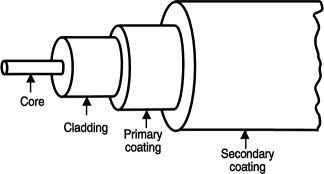
Types of Optical Fiber:
There are many types of optical fibres. However, the most significant types are
1- Single-mode Optical Fiber
A fibre that is designed to carry a single signal at a time
2- Multi-mode Optical Fiber
A fibre that is designed to carry more than one signal at a time
Working of Optical Fiber:
In a fibre-optic system, the transmitter turns information into light and sends it through optical fibres. As light moves at a high speed through the core, light bounces off the cladding either by the phenomenon of total internal reflection or continuous refraction. If the fibre has a curve or bends in it, the light can bounce off the cladding and follow the cladding by turning the corner. At the end of the fibres, the receiver accepts the light and turns the light back into sound, pictures, or computer codes.

Uses of Optical Fibers:
✔ They are used as light guides, imaging tools and also as lasers for surgeries.
✔ Fiber is used for transmitting and receiving purposes in telecommunication.
✔ Optical fibres are used as hydrophones for SONAR and seismic waves, as wiring in submarines, aircraft, and other vehicles and for field networking too.
✔ They are used for imaging in hard-to-reach areas, as wiring where EMI is an issue, as sensory devices to make temperature, pressure and other measurements, and as wiring in automobiles and in industrial settings.
b. Global Positioning System
The Global positioning system (GPS) is the state-based radio navigation system that uses satellites a receivers to synchronize location, velocity, and time data for air, land, and sea travel.
The invention of GPS:
USA initiated the GPS project in 1973 to overcome the limitations of previous navigation systems. It became fully operational in 1995. Bradford Parkinson, Roger L. Easton, and Ivan are credited for their inventions.
Components of GPS:
GPS is made up of three different components that are called segments, which work together and provide location information.
The three segments of GPS are given below
1- Space (Satellites)
Satellites circulating the earth transmit signals to users on geographical position and time of day.
2- Ground control:
It is made up of earth-based monitor stations, master control stations, and ground antennae. It controls activities including tracking and operating the satellites in space and monitoring transmission
3- User equipment
GPS receivers and transmitters including items like watches smartphones, and telematics devices. GPS is a dependable and powerful tool for businesses and organizations in many different industries.


Question – 04
(A) What are vaccines? Classify these and discuss DNA vaccines in detail.
Question Breakdown
The question mainly consists of two parts. In the first part, the examiner has asked you to explain vaccines in your own words, and in the next part, he has particularly demanded the Classification and explanation of DNA. Thus, start with defining the vaccines with appropriate examples. Then move to the classification of vaccines, eluding the name-key of each type. Later on, define briefly DNA vaccines with examples. Remember since the examiner has already given you a lot to crack, try to be relevant in your answer as much as you can.
Answer:
Vaccines:
Vaccines are the suspension of microorganisms that induce antibody production inside the body for protection against disease by producing immunity.
For Example:
✔ Measles and mumps vaccines
✔ Polio vaccines
✔ Covid-19 vaccines (etc)
Classification of Vaccines:
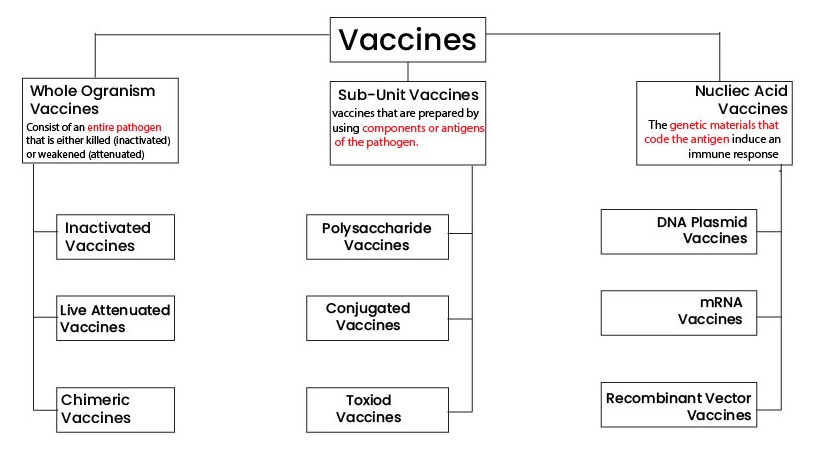
DNA Vaccines:
DNA vaccines are the types of nucleic acid vaccines. In DNA vaccines, a small circular piece of genetically engineered DNA-plasmid- is directly injected into cells to produce antigen and then immunity for protection against the disease.
For example:
✔ ZyCov-D Vaccine for SARS coronavirus (SARS-CoV)
✔ H5N1 avian influenza
✔ H1N1 pandemic influenza
Formation and Working of DNA Vaccine:
1- The first step is the selection of desired antigen sequence.
2- The second step is the isolation of genomic DNA from the selected antigen.
3- The third step is the cloning of vaccine antigens in the plasmid.
4- The fourth step is the transformation and culture of the plasmid into bacteria, where bacterial growth produces multiple plasmid copies.
5- In the fifth step, the plasmid DNA is purified by separating the circular plasmid from the much larger bacterial DNA and other bacterial impurities.
6- The purified plasmid DNA is used as the vaccine.
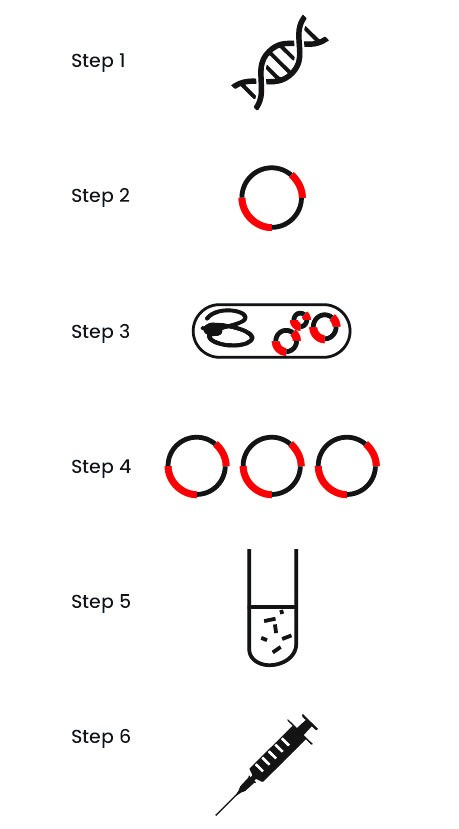
Advantages of DNA vaccines
1- In DNA vaccines, actual infectious organisms are not used.
2- Normal vaccines provide primarily Humoral Immunity- involve substances found in the humour or body fluids. On the other hand DNA vaccines provide both Humoral as well as Cell-mediated immunity.
Limitation of DNA Vaccines
1- It has a risk of uncontrollable cell growth affecting genes.
2- It has the possibility of tolerance to the antigen.
3- It is limited to the protein immunogen.
4- It has only potential for atypical processing of bacterial and parasitic protein.
(B) What are causative organisms and vectors for dengue, enlist possible ways of preventing dengue
Question Breakdown:
In the question, the examiner has asked you to explain the causative agents of Dengue and ways to prevent it. Thus, mainly the question has two parts. For the first part, start your answer with the proper definition of Dengue Fever in your own words. Then, write down the causative agent along with the vector of the disease. Remember, Causative agent are organisms which are collectively referred to as biological pathogen that causes a disease, while Vectors are those organisms that carry the pathogen from one human to another. Last, write down the reasonable preventive measures for Dengue fever-minimum five- in bullets.
Answer:
Dengue Fever:
Dengue fever is a kind of viral infection transmitted through the bite of infected mosquitoes called dengue virus (DENV).
Causative Agents:
The virus causing dengue fever belongs to the Flaviviridae family.
There are four distinct dengue viruses (DENV-1, DENV-2, DENV-3, and DENV-4) without cross-immunity. Dengue infections infect humans up to four times in their lifetime. It is widely accepted that all four viruses are of Asian origin.
Vector for dengue:
Vectors are the primary agents that are responsible for the spreading of disease. The primary vector that is responsible for the dengue virus is known as Aedes aegypti mosquitoes and, to a lesser extent, Ae. albopictus.
Preventive measures for dengue:
Dengue can be prevented by the following measures:
1- Wear loose, light-coloured, long-sleeved shirts, and use insect repellent-DEET containing – on exposed body parts.
2- Take extra preventive measures when engaging in outdoor activities, avoid using fragrant cosmetics or skin care products, and re-apply insect repellents according to instructions.
3- Prevent accumulation of stagnant water. For this purpose, change the water in indoor plants once a week, lid water containers tightly, keep air-conditioner drip trays free of stagnant water, and put all used cans and bottles into covered dustbins
4- Control vectors and reservoirs of the diseases by disposing off garbage adequately.
5- Pregnant women and children of 6 months( not infants) or older can use DEET-containing insect repellent. Further, children aged 2 months or above can use DEET-containing insect repellents with a concentration of DEET up to 30%.
Question – 05
(A) Comment, ‘liver is the chief chemist in the human body.’
Question Breakdown:
In the question, the examiner simply asked you to explain the function of the liver. Thus, start your answer by giving the general information: occurrence, weight, size, etc., of the liver in your own words and then move to the function of the liver in all the processes individually. You can also draw a table to clarify the roles played. Remember, writing too much and never help you obtain maximum marks in GSA Paper; instead, make sure what you write must be relevant and complete.
Answer:
Liver:
The liver-the chief chemist of our body- plays a significant role in detoxification in the human body.
Location:
The liver is an organ located in the right upper quadrant (RUQ) of the abdomen under the diaphragm.
Weight:
The liver weighs approximately 1.4 kg and is known as the heaviest organ of the body.
Why is it called the chief chemist of the human body?
The liver is a chemical factory, performing around 500 chemical functions in your body. The liver takes certain materials in your body and turns them into something else. For example, your liver turns proteins and sugars into glucose your body needs.
Role of Liver:
✔ Manufacturing
After making thousand plus essential proteins, enzymes, and hormones, it transports them throughout the body. It helps in coagulation for the prevention of bleeding to death. Only with the help of bile produced by the liver does the emulsification of the fats, not the absorption of A, D, E, and K vitamins from the gut into the bloodstream, and the removal of toxins, can be processed.
✔ Storage
It has the function of storage of Iron to make RBCs and glycogen to regulate glucose levels, vitamins, and minerals.
✔ Detoxifier
It acts as a detoxifier because of receiving toxins and then converts them into water-soluble substances for elimination through sweat, bile, and urine. It cleans up almost 100 gallons of blood per day.
✔ Filtration
It filters and detoxes unhealthy cells, bacteria and other microorganisms and eliminates them.
✔ Regulation
It regulates iron absorption, blood sugar and fat metabolism, hormonal balance, and blood pressure.
To conclude, the liver performs all functions: digestion, detoxification, synthesis, storage, elimination, and regulation.
(B) What is Cholesterol? Discuss its importance, average blood level and dangers of elevated levels concerning the health and disease in humans
Question Breakdown:
The question consists of many parts. First, you are supposed to explain cholesterol in your own words giving definitions, sources, importance, etc… Next, draw a table demonstrating all its average values in the blood. Last, explain the consequences of raised blood cholesterol- i.e., two to three cardiovascular diseases. Although you do not need to draw any diagram for this question, making a relevant diagram can help you get maximum marks.
Answer:
Define Cholesterol:
Cholesterol-a fat-like substance- is found in the human body and food. It is necessary for human life. It has many functions, like it gives strength to cells, producing bile, and making hormones and Vitamin D. The liver is the central organ of the human body where it is produced. Cholesterol is insoluble in blood; it is carried around in tiny packages called lipoproteins.

Importance of Cholesterol
✔ Hormones production
Cholesterol is needed to manufacture steroid-based hormones, particularly sex hormones like testosterone and progesterone.
✔ Formation of bile juice
Cholesterol helps the body form bile acids, which are needed to break down fats in the digestive tract for their proper absorption into the body.
✔ Source of energy
Triglycerides are a significant energy source for the body, mainly when glucose is deficient.
✔ Essential Component of Cell membrane
Cholesterol is an essential component of cell membranes- the structures that border every cell in the human body. T-cells (white blood cells), for example, without cholesterol, would not maintain their cell membranes, leading to rupturing of the cells.
✔ The production of Vitamin D
Cholesterol is essential for the body in vitamin D production
Average Blood Level of Cholesterol
Cholesterol levels are measured in milligrams (mg) of cholesterol per deciliter (DL) of blood.
| HDL | 40mg/dl |
| LDL | less than 100 mg/dl |
| VLDL | 2-30 mg/dl |
| CHOLESTEROL | <200mg/dl |
| T.G | 150mg/dl |
Dangers to the health of High Cholesterol
Harmful effects of elevated level of cholesterol
✔ Coronary artery disease:
Too much cholesterol in the blood has the capability to combine with other substances and form plaque. Plaque, consequently, sticks to the arterial walls-atherosclerosis. It can cause coronary artery disease, where coronary arteries become narrow or even blocked.
✔ Heart attack
If the flow of oxygen-rich blood to the heart muscle is reduced or blocked by cholesterol plaque, it can cause a heart attack or angina (chest pain)
✔ Plaque in other areas of the body
Plaque can also build up in other arteries in the body, including those that bring oxygen-rich blood to limbs and the brain. This can lead to stroke, carotid artery disease, and peripheral arterial disease.
Question – 06
(A) What do you know about Remote Sensing Techniques? Explain resolution and write down the names of its various types.
Question breakdown:
In this question, the examiner has asked you to define the remote sensing techniques and explain the resolution with names and types. So, first, define remote sensing and write bullet points explaining its advantages. Then, elucidate the kinds of solutions. Remember, creativity is key to attaining a good score in the General Science and Ability paper.
Answer:
Remote Sensing Technique:
Remote sensing is the study of objects- mainly the things on the Earth’s surface, such as water bodies and vegetation for civil engineers) without being in contact with those objects using images captured with the help of electromagnetic radiation. In remote sensing, objects are studied from a distant location. It relies on various devices and instruments, such as satellites, aerial cameras etc., for capturing imagery.
Advantages of Remote Sensing Technique:
✔ It is used to gather details about the Earth and other solar planets.
✔ Tracking and analysis of clouds can be done through remote sensing.
✔ It allows meteorologists to predict and observe weather patterns, volcanic eruptions, and sea movements.
Resolution:
Resolution explains how data can be used from a sensor. It can vary depending on the sensor design and the satellite’s orbit.
There are mainly four types of resolution.
1- Radiometric resolution:
The amount of information in each pixel, that is, the number of bits representing the energy recorded. Hence, the higher the radiometric resolution, the more values to store information, providing better discrimination between even the slightest differences.
For example, radiometric resolution is necessary to distinguish between subtle differences in ocean colour while assessing water quality.
2- Spatial resolution:
Spatial resolution is the size of each pixel within a digital image and the area on Earth’s surface represented by that pixel. The finer the resolution, with the number being the lower, the more detail you can see.
3- Spectral resolution:
The spectral resolution is the sensor’s ability to discern finer wavelengths having more narrower bands. Many sensors are considered to be multispectral.e., they have 3-10 bands. The narrower the range of wavelengths, the finer the spectral resolution.
4- Temporal resolution:
Temporal resolution is the time a satellite takes to complete an orbit and revisit the observation area. The resolution depends on the orbit, the sensor’s characteristics, and the swath width.
(B) What is a hydrological cycle? Discuss its importance
Question Breakdown
In this question, the examiner has asked you to explain the hydrological cycle. Therefore, you need to answer your question with the definition of the hydrological cycle, the steps involved in the hydrological cycle, and its importance. To score maximum marks, add a labelled diagram of the hydrological cycle. Remember, being creative is the key to attaining a good score in the General Science and Ability paper.
Answer:
Hydrological Cycle:
The hydrological cycle involves the continuous water circulation in the Earth’s Atmosphere system. The water cycle is the water’s motion from the ground to the atmosphere and back again. Hence, the reason behind the rain, cloud, etc. can be understood by studying the water cycle or hydrological cycle.
Steps involved in the hydrological cycle:
Following are the steps of the water cycle
1- Evaporation:
In the first step of the water cycle, water from the liquid state is converted into the gaseous state in the presence of sunlight and high temperature. However, the rate of evaporation will be high at high temperatures and will be low at low temperatures.
2- Transpiration
Transpiration is a process involving the loss of water vapour through the stomata of plants- an opening on the leaf through which the excess water is excreted by the plants. The number of stomata openings varies in number from side to side of a leaf. Water is excreted from the stoma and found on the surface of the leaf.
The combination of evaporation and transpiration is called evapotranspiration.
3- Condensation
When vapours go up, in the air, at some stage, they condense and convert back into liquids due to low temperature. It is called condensation. It is the process that becomes the cause of cloud formation.
4- Precipitation
At this stage, liquid droplets combine together, increasing their mass. Thus, as the mass of the droplets increases, they fall upon the Earth in different forms, i.e., rainfall, hail storm, snow, sleet, etc.; all of them are different types of precipitation.
5- Runoff/ Surface runoff
Whenever water hits the Earth, it runs over the surface of the Earth to reach streams or lakes, known as runoff.
6- Infiltration
When rainwater seeps through the Earth and moves down to recharge Aquifers, the process is known as infiltration.
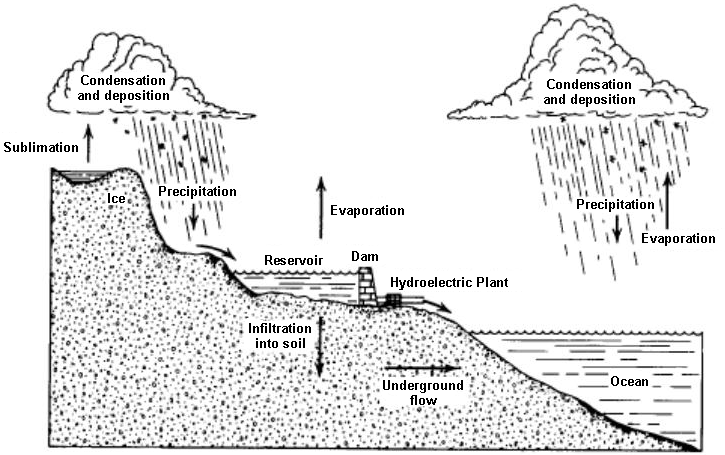
Importance of hydrological cycle:
✔ The significance of the hydrological cycle is as follows.
✔ It is involved in maintaining aquatic ecosystems.
✔ The hydrological cycle is essential for the maintenance of life.
✔ It plays an important role in ensuring the availability of water for all living organisms.
✔ It also plays a significant role in the continuous movement of water above and below the surface of the Earth.

Question – 07
(A) What is a tsunami? How are the tsunamis generated, and what are their characteristics?
Question Breakdown:
In this question, the examiner has asked you to define a tsunami and shed some light on the way tsunamis are generated. so, you have to delineate the whole process of tsunami formation. Further, you are required to enlist some characteristics of tsunamis. You can make your answer stand out by adding a piece of interesting information like a fact about the deadliest tsunamis in history. Remember, creativity is the key to scoring good marks in the GSA paper.
Answer:
Tsunami:
Tsunamis are large ocean waves that can grow in size and reach the shore. This causes major damage as they are very powerful and large waves, as they rush inland and can destroy cities and homes.
Most Destructive Tsunamis:
✔ Sumatra Indonesia 26 December 2004
✔ North pacific coast, Japan 11 March 2011
Generation of Tsunami:
Tsunami occurs in water, with most of their occurrence in the Pacific Ocean, where there are lots of underwater earthquakes and volcanoes due to the high pressure. However, tsunamis can happen anywhere. For the high pressure, the water displaces and moves forward on the shore, which creates large waves of water. Most tsunamis are caused by earthquakes. They are dangerous because they can still be travelling at highway speeds of over 50 miles per hour.
Characteristics of Tsunami:
Tsunamis are characterized as shallow-water waves. A tsunami can range from ten minutes to two hours and a wavelength in excess of 300 miles (500km).
✔ Earth’s most infrequent hazard.
✔ Most tsunamis are small and nondestructive because of the lower pressure of water from the backside.
✔ Wavelength is directly proportional to the depth.
✔ There is no season for tsunamis, and all tsunamis do not act the same. It cannot be predicted where, when and how destructive it will be.
(B) What is an earthquake? Discuss the Richter scale in this context. What was the intensity of the earthquake in Pakistan dated 26 October 2015, and where was the locus?
Question Breakdown:
In this question, the examiner has asked you to answer multiple questions. So, what you have to do is give the required weightage to each of them. First, you have to define an earthquake, along with giving some information about the disaster. Adding a diagram to clearly explain the concept would make your answer stand out. Second, you have to give an understanding of the Richter scale. Last, you are required to mention the exact intensity and locus of the October 2015 earthquake. Remember, making diagrams and charts and being creative can help you score high in the GSA paper.
Answer:
Earthquake:
An earthquake is a sudden energy release in the form of seismic waves that creates a strong vibration and makes the earth’s surface completely rugged. The wave causes the earth’s crust to into large pieces, and the surface of the earth suddenly slips.
✔ The surface where the earth slips are called Fault/Focus.
✔ The surface where the earthquake starts is known as the Hypocenter.
✔ The surface directly above the hypocenter is called an Epicenter.

Ritcher Scale:
Ritcher scale is a scale that was originally used to measure the magnitude of earthquakes ranging from 0 to 10 on the basis of the size of seismograph oscillations. The number-from one to ten-is ascertained and calculated with the help of information that is gathered by a seismograph. It is basically used to indicate the intensity of an earthquake and how intense the earthquake was.
| Magnitude on Richter Scale | Description | Effects of the Earthquakes | Occurrence Frequency |
| Less than 2.0 | Micro | The earthquake is not felt | Approximately 8000 per day |
| 2.0 to 2.9 | Minor | Normally not felt, but recorded | Approximately 1000 per day |
| 3.0 to 3.9 | Minor | Normally felt, but the likelihood of damage is rare | Approximately 49,000 per year |
| 4.0 to 4.9 | Light | Often felt indoors, with shaking of indoor items and rattling noises. | Approximately 6200 per year |
| 5.0 to 5.9 | Moderate | Major damage can be caused to poorly constructed buildings. | Approximately 800 per year |
| 6.0 to 6.9 | Strong | It can be very destructive in areas as far as 160 kilometres from the epicentre. | Approximately 120 per year |
| 7.0 to 7.9 | Major | It is known to cause severe damage over larger areas. | Approximately 18 per year |
| 8.0 to 8.9 | Great | It can cause severe damage several hundred miles across. | Approximately 1 per year |
| 9.0 to 9.9 | Great | Devastating in areas for several thousands of miles | Approximately 1 per 20 years |
| 10.0 + | Epic | Has never been recorded | Extremely low and cannot be estimated |
It must be noted that the effects of the earthquakes that are given in the aforementioned table are for shallow earthquakes in a populated area. Other factors, such as the local surface and subsurface geologic conditions, etc., have a role to play.
Intensity and locus of the earthquake happened on 26 October 2015
a. Intensity:
According to the Pakistan Meteorological Department, the earthquake that shook Afghanistan, Pakistan, and parts of India at 2:09 pm Pakistan time on 26 October 2015 is measured at 8.1 on the Richter scale.
b. Locus:
The epicentre of the massive quake originated around 150 miles below the earth’s surface, located in the mountains of Hindu Kush in the Badakshan-Province of Afghanistan.
Question – 08
(A) Explain the shape of the water molecule with the help of Molecular Orbital Theory; also draw its orbital diagram.
Question Breakdown
In this question, the examiner has asked you to explain the shape of the water molecule with the help of Molecular Orbital Theory with a diagram. So, all you have to do is define the term molecular orbital theory and delineate the steps of water molecule formation. Then, draw a basic diagram and briefly explain the process.
Answer:
Molecular Orbital Theory:
According to Molecular Orbital Theory, the atomic orbital of the combining atoms overlap to form new molecular orbitals that cover the whole molecule in one unit. Two orbitals after overlapping form two molecules: bonding molecular orbitals with low energy (σ) and anti-bonding molecular orbitals with high energy (σ*)
Molecular Orbital Structure of H2O:
The water molecule has 10 electons and 10 protons; thus, its electronic configuration is
H2O = 1s2, 2s2, 2p6
The water molecule has a bent or angular shape with two lone pairs and two bond pairs of electrons.

(B) What are the gamma rays? Explain their applications.
Question Breakdown
In this question, the examiner has asked you to define gamma rays and explain their applications. So, all you have to do is begin with definitions of the gamma rays, their characteristics, and their applications in bullets. Remember, writing too much will never reward you highest marks; what awards you maximum marks is to address what is asked. Remember, in the GSA paper, creativity is the key to making yourself stand out from other aspirants.
Answer
Gamma rays:
Gamma rays are electromagnetic radiation of the shortest wavelength and highest energy that is produced in the decay of certain subatomic particles and in the disintegration of radioactive atomic nuclei.
The term gamma ray was coined by British physicist Ernest Rutherford in 1903 following early studies of the emissions of radioactive nuclei.
Characteristics of gamma rays:
✔ Gamma rays do not have any charge on them
✔ A typical source of gamma rays is cobalt-60.
✔ Ionization of gamma rays is about one ion pair mm-1 in air
✔ Its absorption power is about 1-10 cm of lead sheet.
✔ The speed of gamma rays in the air is 3*108 ms-1
Application of gamma rays:
✔ Gamma rays are used to sterilize and disinfect medical equipment.
✔ Gamma rays are used to detect cracks according to variations in thickness. It can also detect density change, weld defect, and non-uniformity of material.
✔ High-energy radiation is used as a tracer in medicine.
✔ Radio Therapy- In oncology, it utilizes gamma rays to kill cancerous cells without surgery by targeting infected DNA.
✔ It is also used in the development of bombs and nuclear reactors.
Question – 09
(A) Discuss the importance of preservatives and antioxidants in food.
Question Breakdown:
In this question, you have to simply define and explain the significance of food preservatives and anti-oxidants in food. Making a chart and presenting your answer in a creative way can help you make your answer stand out and thus score high in such simple questions.
Answer:
| Characteristics | Food Preservatives | Anti-Oxidants |
| Define | Food preservatives are chemicals or substances that are used to preserve food from getting spoiled by bacteria, fungi, mould, or any other substance. | Antioxidants are any of various chemical compounds added to a certain food to retard autoxidation, the process by which these substances combine with oxygen in the air at room temperature. |
| Example | • Tetracycline- an antibiotic used to prevent the growth of harmful bacteria in poultry, fish, and canned food. • Antimycotics- inhibit the growth of moulds in cheese and fruit juice. | • Ascorbic Acid (Vitamin C) • Naturally occurring Propyl gallate • Butylated Hydroxy Toluene (BHT) |
| Importance | • Food preservatives Increase the life of food thus increasing the supply. • Due to preservatives, seasonal fruit is available throughout the year. • They add variety to the food. • Preservatives in food stabilize the pricing of the food as there is no risk of shortage. | • Antioxidants prevent food from rancidity and spoilage. • Food keeps its taste and colour for a long time if antioxidants are used. • They help in slowing the process of deterioration when exposed to air. • Antioxidants increase the productivity of the food. |
(B) Comment, Green House Effect is a blessing. Also, discuss Enhanced Green House Effect and its relation with global warming.
Question Breakdown:
This question starts with a declarative statement. It doesn’t have much to do with your answer. So, you can just mention how it is a blessing and then move to the subject matter. The question requires you to explain the working of the Greenhouse Effect with respect to its causing the increase in the average global temperature. You may also mention the major factors that lead to an increased greenhouse effect. Remember, you can score high by being creative and adding a diagram for explaining the concept.
Answer:
Yes, the Greenhouse effect is a blessing because, in the absence of the greenhouse effect, the earth’s atmosphere would not be warm enough to make life possible on earth. The greenhouse produces the warmth necessary for the survival of life on earth.
How does the greenhouse effect work?
The greenhouse effect is a process in which some gases, like CO2, trap the heat while it radiates back into the atmosphere. The heat trapped is then released at night time. Other than the greenhouse effect, our atmosphere already absorbs some heat.
Example
The greenhouse effect works like a greenhouse. It is used to grow tropical flowers and plants. The greenhouse is a building with glass walls and a glass roof. The glass walls can trap heat. The same heat warms the plants during day time and at night when it is colder outside.
Diagram

Enhanced greenhouse effects and their relation to global warming
The enhanced greenhouse effect is also known as “climate change or global warming”. This increased warming happens due to the increased level of carbon dioxide and other heat-absorbing gases in the atmosphere. Such gases increase the earth’s temperature from the natural greenhouse effect to the enhanced greenhouse effect, which leads to the increased warming of the earth’s atmosphere and results in global warming.
Significant factors are contributing to “enhanced greenhouse effects.”
1. Deforestation to reduce and store CO2
2. Production of CO2 from the burning of fossil fuels
3. Release of CO2 from cement production
4. Release of nitrogen oxide from the use of high nitrogen fertilizers
5. Intensive production of livestock, which produces methane
Question – 10
(A) Define and draw the following
(i) Right-angle triangles
(ii) Equilateral triangles
Answer:
1- Right-angle triangles
A right-angled triangle is a type of triangle that has one of its angles equal to 90 degrees. In a right-angle triangle, the hypotenuse is the longest side always opposite the right angle. Its base is the one that adjoins the right angle and it is the bottom line which also forms an angle theta with the hypotenuse. The third line is known as the height/leg/altitude which is opposite to the angle theta. This line is always perpendicular to the line containing the base.
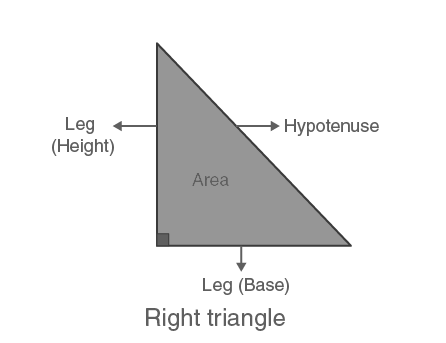
2- Equilateral triangles
An equilateral triangle, in geometry, is a triangle that has all three sides equal in length. Also, the three angles of the equilateral triangle are congruous where each angle is equal to 60 degrees. Therefore, it is also known an equiangular triangle.
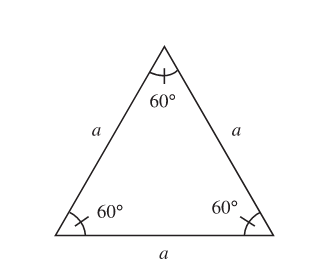
(B) There are nine students in a group having ages 15, 15, 16, 16, 16, 17, 17, 18, 19. Calculate mean, medium, mode and range of their ages also define the above mentioned terms:
Solution:
Since mean is the sum of all the values divided by total number of values

As median is the middle value of the arranged data. To find the middle value we know the formula is as follows;

So, the 5th value in the data (arranged in an ascending manner) is the median. As the 5th value is 16 so, the median is 16
Since mode is the most frequently used value in the data and 16 is the most used value. Thus,
Mode = 16
So, the mode is 16
As Range is the difference between maximum value and minimum value of the data. In the above given data, the largest value is 19 and the smallest value is 15. Thus,
Range = Xm – Xo
= 19 – 15
= 4
So, range is 4
Question – 11
(A) A distribution company provides households to departmental stores within a 50 kilometres radius. The table below shows how far each departmental store is from the godown of the distribution company.
| Distance from the godown of the distribution company | Number of Stores |
| 10 kilometres or less | 03 |
| 11 to 20 kilometres | 15 |
| 21 to 30 kilometres | 26 |
| 31 to 40 kilometres | 20 |
| 41 to 50 kilometres | 16 |
(i) How many stores does the distribution company serve?
(ii) What is the most common distance of stores from the company go down?
(iii) How many stores are 35 Km or more from the go-down?
(iv) What percentage of stores are 31 Km or more from the go-down?
Answer:
Number of stores = sum of all the stores
= 03+15+26+20+16
= 80
So, the company serve 80 stores
The most common distance is the one in which maximum stores are present.
So, the most common distance is 21 to 30 kilometres
There are more than 16 stores between 35 to 50 kilometres
The number of stores from 31 kilometers or more is 36
The total numbers of stores are 80
Since,
Percentage = Given stores/ Total no. of stores x 100
= 36/80 x 100
= 45 %
So, the required percentage is 45 %
(B) Read the following carefully and answer the questions following: Ahmad, Ali, Akbar, Nasir and Shehbaz are students of a college having different heights and weights. Ahmad weighs thrice as much as Ali and Ali weighs 5 times as much as Akbar. Akbar weighs half as much as Nasir and Nasir weighs half as much as Shehbaz.
(i) Who is the heaviest in weight?
(ii) Who is the lightest in weight?
(iii) Shehbaz is lighter in weight than which of the two students?
(iv) Shehbaz is heavier than which of the two students?
(v) Show the descending order of weights of the students?
Solution:
Ahmed = 3(Ali), it means Ahmed is heavier than Ali
Ali = 5(Akbar), it means Ali is heavier than Akbar
Akbar = 1/2(Nasir), it means Nasir is heavier than Akbar
Nasir = 1/2(Shehbaz), it means Shehbaz is heavier than Nasir
The relation would be
Ahmed > Ali > Shehbaz > Nasir > Akbar
- The heaviest in weight is Ahmed
- The lightest in weight is Akbar
- Shahbez is lighter than Ahmed and Ali
- Shahbez is heavier than Nasir and Akbar
- The descending order is Ahmed > Ali > Shehbaz > Nasir > Akbar
Question – 12
(A) Classification of blood groups is based on the presence or absence of inherited antigenic substances on the surface of red blood cells. In a survey of British population the blood group distribution among 1000 people was as follows: 300 had blood group A, 325 had blood group B, 250 had O and 125 AB. Out of this group a person was selected at random, calculate his probability of having blood group AB
Solution
Blood group A = 300
Blood group B = 325
Blood group O = 250
Blood group AB = 125
Total Person = 1000
No. of Elements = 125
No. of Sample space = 1000
Now, we know that no of elements n(E) is the no of favorable chances for an event to occur and sample space n(S) is the total number of outcomes. So, we can write;
Probability = No of Elements/ No. of Sample spaces
= 125/1000
Probability =1/8 or 0.125
(B) Five friends Ahmad, Ali, Akbar, Nasir and Shehbaz went on summer vacation to five cities namely V, W, X, Y and Z by five different modes of transport, that is by bus, train, aero plane, car and boat from point A. Akbar went to Y by car and Ali went to X by air. Nasir travelled by boat whereas Shehbaz went by train. For X and W, there is no bus service. The person who went to X did not use boat to travel. Now answer the following questions.
(i) How did Ahmad travel and where did he go?
(ii) Which mode of transport was used by the person who travelled to X city?
Solution:
Given data
Friends = Ahmed, Ali, Akbar, Nasir, Shahbaz
Cities = V, W, X, Y, Z
Transport = Bus, Train, Aeroplan, Car, Bus
Akbar went to Y by car
Ali went to X by air
Nasir went by boat
Shahbez went by Train
Ahmed went by Bus and Bus do not went to X and W so,
- Ahmed travel by Bus and went to V or Z
- The person who went to X travel through Aeroplane

Question – 13
(A) Differentiate between primary and secondary mental abilities. How the general mental ability scales differ from IQ test.
Answer
Mental Abilities:
a. Primary mental abilities
These are thought to be large-scale groups with similar abilities. It includes:
✔ Word fluency: It is mainly the ability to make words rapidly
✔ Verbal comprehension: The ability to describe and understand words
✔ Spatial visualization: It is the ability to visualize the different relationship
✔ Number Facility: The ability to solve mathematical problems
✔ Associative memory: The ability to memorize and recall
✔ Reasoning: The ability to find out the rules
✔ Perceptual speed: The ability to see differences and similarities among different objects
b. Secondary mental abilities
These build off foundational primary mental abilities of intelligence. It includes:
✔ Fluid intelligence (flexibility, adaptiveness and relational thinking)
✔ Crystallized intelligence (breadth of knowledge).
How does the general mental ability scale differ from the IQ tests?
While both aptitude testing and IQ testing aim to measure brainpower, they do so in different ways. Generally speaking, mental ability scales can measure specific areas of intelligence/abilities of a person whereas IQ measures the general intelligence of a person in comparison with other people. Moreover, in mental ability scales, age is not a factor but to determine IQ score, age is required. Not to speak of that, there is a separate score for each category when measuring general ability scales; whereas, in IQ tests, there is one single score as a whole.
(B) Y = mX + C is an equation of straight line. Draw a graph showing relationship between X and Y and relate the equation to the slope and intercept on the graph.
Answer
Since, Y=mX represent a straight line graphically.
We have a straight line having slop “m” and Y-intercept (the point where the line intercept y-axis) is “C”
Let we take a point P(x,y) on the line
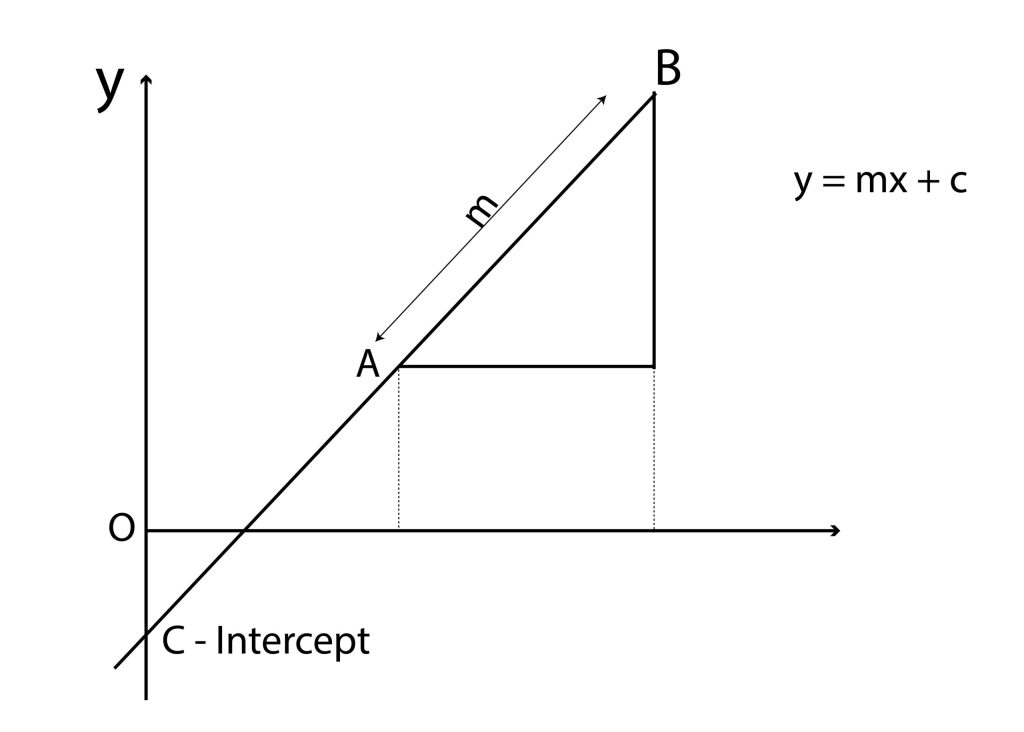

CSS Solved Past Papers’ Essays
Looking for the last ten years of CSS and PMS Solved Essays and want to know how Sir Kazim’s students write and score the highest marks in the essays’ papers? Then, click on the CSS Solved Essays to start reading them.
CSS Solved Essays

CSS Solved General Science & Ability Past Papers
Articles Might Interest You!
The following are some of the most important articles for CSS and PMS aspirants. Click on any to start reading.






